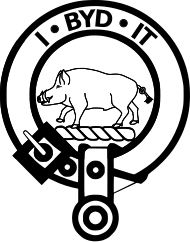Clan Nisbet
| Clan Nesbitt or Nisbet | |||
|---|---|---|---|

Crest: A boar passant Sable, armed Argent, langued Gules
|
|||
| Motto | I Byd It (I endure) | ||
| Slogan | "A Nisbet" | ||
| Profile | |||
| Region | Borders | ||
| District | Berwickshire | ||
| Plant badge | Oak | ||
| Chief | |||
 |
|||
| Mark Nesbitt of that Ilk | |||
| Chief of Clan Nesbitt | |||
| Historic seat | Nisbet House | ||
|
|||
Clan Nesbitt (or Clan Nisbet) is a Scottish clan of the Scottish Borders that is recognised by the Lord Lyon King of Arms.
The surname Nesbitt is derived from the barony and lands near Edrom in Berwickshire. The lands are likely to have been named after a geographical feature such as a nose-shaped hill or nose-shaped bend. In clan circles the name is best known through the work of Alexander Nisbet (1657 - 1725), who was one of the greatest authorities on Scottish heraldry. Alexander Nisbet established his connection to the chiefly line of the clan and he is regarded as authoritative on the pedigree of his own family. He stated that the lands of Nesbit were of ancient denomination for, in the reign of King Edgar, son of Malcolm Canmore, in whose reign surnames came first to be hereditary, they were donated to the monks of Dunfermline to pray for the soul of his father, and for the health of his own.
The historian George Fraser Black listed William de Nesbite as a witness to a charter by Patrick, Earl of Dunbar to Coldingham Priory in about 1160. From 1219 to 1240 Thomas Nisbet was Prior of Coldingham.
In 1296 Philip de Nesbit appears on the Ragman Rolls submitting to Edward I of England. Also appearing on the rolls are James, John and Adam Nisbet. It is likely that Adam was the Nisbet of that Ilk who received a charter from Robert the Bruce for the land of Knocklies with the feudal obligation of providing one knight for the king's army. Adam or possibly his son of the same name continued in royal favour, distinguishing himself in defending the Scottish Borders in the service of David II of Scotland.
Adam was succeeded by Philip Nisbet, who appears in important charters of the Earls of Dunbar. Philip was succeeded by his son Adam. Adam's great-grandson was another Philip Nisbet who married a daughter of Haldane of Gleneagles and their heir was Alexander Nesbit.
...
Wikipedia
